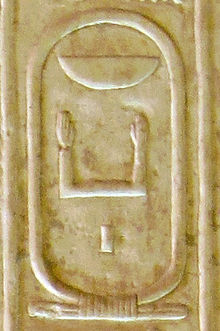Nebka
| Nebka | |
|---|---|
| Necherophes, Necherochis, Sanakht ? | |

Cartouche name of Nebka as shown in the Abydos King List.
|
|
| Pharaoh | |
| Reign | uncertain, 19 years according to the Turin Canon(3rd Dynasty) |
| Predecessor | Sekhemkhet (most likely) or Khasekhemwy |
| Successor | Khaba (most likely), Huni or Djoser |
Nebka is the birth name of an Ancient Egyptian king (pharaoh) who ruled during the 3rd dynasty of the Old Kingdom. He is thought to be identical with the Hellenized name form Necherophes (by Manetho). Nebka is one of the most disputed kings of the Old Kingdom, since his name is handed down as cartouche name only, but is preserved always in the same typographical way. And because the sources for the name “Nebka” are that numerous, this ruler is seen as a historically important figure.
The earliest source for Nebka´s name is the mastaba tomb of a high official named A'akhty, who lived and worked at the end of 3rd dynasty. The chronologically next source is the famous Westcar Papyrus of 13th dynasty, in which a king “Nebka” appears within a story known as “Nebka and the crocodile”. The next sources are all from 19th dynasty. The Royal Table of Saqqara though lists no “Nebka”, but instead a king “Nebkarâ” and places that name close to the end of 3rd dynasty, as the direct predecessor of Huni (who was the last king of the 3rd dynasty).
Even today, egyptologists are disputing the identity and chronological position of Nebka. Some scholars, such as Toby Wilkinson, Kenneth Anderson Kitchen, Stephan Seidlmayer and Rainer Stadelmann are convinced, that Nebka was identical with a king Hor-Sanakht. Their assumption is based on a single clay seal fragment, which shows traces of a sign which the egyptologists believe to be the rest of a cartouche with the sign Ka from “Nebka”.
Egyptologists such as John D. Degreef, Nabil Swelim and Wolfgang Helck contradict the identification of Nebka with Sanakht. They point out that the remains of the inscriptions on the clay seal in question is that damaged, that the alleged cartouche can be hardly identified as such. Instead, it could also be the rest of an oval shaped crest of a royal fortress with one or several boats in it, this city was already mentioned under king Peribsen by its name “Elder´s boats”. The clay seal as a proof was therefore not convincing enough. They also point out, that the mother of king Djoser, queen Nimaethap, was entitled as a “Mother of a king”, and that this title was used in a singular form. Therefore, she should have had only one son, who ascended the throne - no place for a “Sanakht” or “Nebka”. Additionally, in the tomb of her husband, king Khasekhemwy, only clay seals of Djoser were found, not a single one of Sanakht or Nebka. Kenneth A. Kitchen (who identifies Sanakht with Nebka) points out, that the Turin Canon inexplicably gives the same length of reign for Nebka (namely 19 years) as it does for Djoser - a circumstance that shouldn´t be. For this reason many scholars believe that the name “Nebka” was simply misplaced by mistake.
...
Wikipedia
